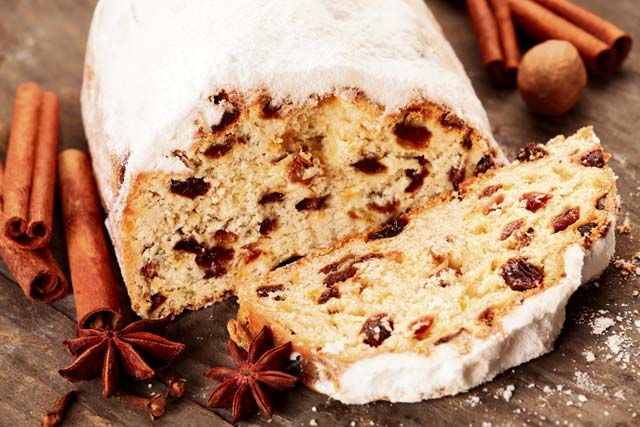
If you haven’t tasted it yet, go ahead! Stollen — or German Christmas bread — is a holiday season must have. With almonds, fruits and marzipan, this cake is a typical Advent delight in Germany.
The “Christstollen,” as it’s properly called in German, dates back to the 15th century. Originally, it was an Advent fasting meal in monasteries made from flour, yeast and water. Since those ingredients didn’t provide much taste, Saxonian nobility asked for authorization to use butter, the use of which had been forbidden by church authorities. But, Pope Nickolaus V denied the request. Fortunately, six decades later the permission did come, and the Holy Father sent the “Butter letter” in 1491.
Ever since, stollen has become a popular cake. Today, you can find more than 12 different types of stollen in Germany, starting with the most known almond and marzipan stollen down to the red wine or oranges and Cointreau stollen.
Basically, many regional bakeries have introduced their individual stollen variation, so it’s best to try them for yourself.
Because stollen originates from the Saxonian capital of Dresden, the locals honor it by organizing the oldest German Christmas market, the Dresdener Striezelmarkt — Striezel being the locals’ name for stollen — from Nov. 27 to Dec. 24 (visit www.dresden.de/en/05/08-Christmas.php).
If you can’t make it to Dresden, bake your own stollen!
INGREDIENTS
50 grams slivered almonds
500 grams raisin
50 grams candied orange peel
50 grams candied lemon peel
50 milliliters rum or apple juice
400 grams flour
1/4 liter milk
1 cube fresh yeast
3 spoons of honey
450 grams butter
1 small spoon of salt
100 cooking marzipan
1/2 vanilla bean
1 organic lemon
Flour for baking preparations
About 150 grams powdered sugar.
INSTRUCTIONS
• Soak the fruit in rum for several hours. If you want to leave out the alcohol, use apple juice instead.
• Pour boiling water on the almonds and leave them for 10 minutes. Then, strain and mix with the fruit. Mix 200 grams flour, tepid milk, crumbled yeast and honey into a pre-dough. Put some flour on it and leave it to rest and rise in a warm place until the surface starts to crackle.
• Cut the vanilla bean open and scrape out the pulp. Add it to the pre-dough with the rest of the flour, 200 grams chipped butter, salt, grated marzipan and the lemon zest. Knead it for 10 minutes. You can also use the dough hook. Once done, again leave the dough to rise in a warm spot for one hour. Cover it with a dry cloth to prevent draft. After that time, the dough should have doubled. Work it again thoroughly on a floured surface and mould it into a bread shape.
• Heat the oven to 200 degrees Celsius and bake your stollen for 15 minutes. After that, reduce oven temperature to 180 C and leave the stollen in the oven for another 45 minutes. If needed, cover the cake after 25 minutes with some baking paper to keep it from getting too dark.
• Once removed from the oven, spread it with melted butter immediately. Professional bakers recommend letting the cake cool down for a day before sprinkling powdered sugar generously on it for a thick coating. Store it in a cool place.
What happens next is entirely up to you! Some wrap it in waxed paper and aluminum foil to let it rest for six weeks at least in order for the stollen to mature. Others leave the cake for a few days only. The Dresden bakeries recommend a maturing time of two weeks. A producer from the Saxonian Ore Mountains even stores his stollen without any wrapping in a real mining tunnel for a month. Whatever your choice may be, why don’t you try it out for yourself?


